
The Montana-class battleships were planned as successors of the Iowa class for the United States Navy, to be slower but larger, better armored, and with superior firepower. Five were approved for construction during World War II, but changes in wartime building priorities resulted in their cancellation in favor of continuing production of Essex-class aircraft carriers and Iowa-class battleships before any Montana-class keels were laid.

A heavy cruiser was a type of cruiser, a naval warship designed for long range and high speed, armed generally with naval guns of roughly 203 mm (8 inches) in calibre, whose design parameters were dictated by the Washington Naval Treaty of 1922 and the London Naval Treaty of 1930. Heavy cruisers were generally larger, more heavily-armed and more heavily-armoured than light cruisers while being smaller, faster, and more lightly-armed and armoured than battlecruisers and battleships. Heavy cruisers were assigned a variety of roles ranging from commerce raiding to serving as 'cruiser-killers,' i.e. hunting and destroying similarly-sized ships.

The Pensacola class was a class of United States Navy heavy cruiser, the first "treaty cruisers" designed under the limitations set by the Washington Naval Treaty, which limited cruisers to a maximum of 10,000 long tons (10,160 t) displacement and a maximum main battery caliber of 8-inch (203 mm).

The Indiana class was a class of three pre-dreadnought battleships launched in 1893. These were the first battleships built by the United States Navy comparable to contemporary European ships, such as the British HMS Hood. Authorized in 1890 and commissioned between November 1895 and April 1896, these were relatively small battleships with heavy armor and ordnance that pioneered the use of an intermediate battery. Specifically intended for coastal defense, their freeboard was insufficient to deal well with the waves of the open ocean. The turrets lacked counterweights, and the main belt armor was placed too low to be effective under most conditions.
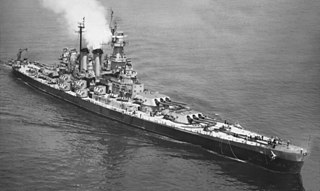
The North Carolina class were a pair of fast battleships, North Carolina and Washington, built for the United States Navy in the late 1930s and early 1940s.

The Nevada class comprised two dreadnought battleships—Nevada and Oklahoma—built for the United States Navy in the 1910s. They were significant developments in battleship design, being the first in the world to adopt "all or nothing" armor, a major step forward in armor protection because it emphasized protection optimized for long-range engagements before the Battle of Jutland demonstrated the need for such a layout. They also introduced three-gun turrets and oil-fired water-tube boilers to the US fleet. The two Nevadas were the progenitors of the standard-type battleship, a group that included the next four classes of broadly similar battleships that were intended to be tactically homogeneous.
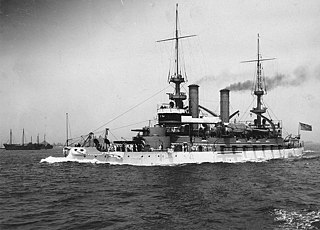
The Kearsarge-class was a group of two pre-dreadnought battleships built for the United States Navy in the 1890s. The two ships—USS Kearsarge and USS Kentucky—represented a compromise between two preceding battleship designs, the low-freeboard Indiana class and the high-freeboard USS Iowa, though their design also incorporated several improvements. Their primary advances over earlier designs consisted of new quick-firing guns and improved armor protection, but their most novel feature was their two-story gun turrets that consisted of a secondary 8-inch (203 mm) gun turret fixed to the top of their primary 13-inch (330 mm) turrets. The ships suffered from a number of problems, however, including a tertiary battery mounted too low in the hull and poorly-designed turrets, though the latter were attempted again with the Virginia class in the early 1900s, also with negative results.

The Connecticut class of pre-dreadnought battleships were the penultimate class of the type built for the United States Navy. The class comprised six ships: Connecticut, Louisiana, Vermont, Kansas, Minnesota, and New Hampshire, which were built between 1903 and 1908. The ships were armed with a mixed offensive battery of 12-inch (305 mm), 8-inch (203 mm), and 7-inch (178 mm) guns. This arrangement was rendered obsolete by the advent of all-big-gun battleships like the British HMS Dreadnought, which was completed before most of the Connecticuts entered service.

The Delaware-class battleships of the United States Navy were the second class of American dreadnoughts; the class comprised two ships: Delaware and North Dakota. With this class, the 16,000 long tons (16,257 t) limit imposed on capital ships by the United States Congress was waived, which allowed designers at the Navy's Bureau of Construction and Repair to correct what they considered flaws in the preceding South Carolina class and produce ships not only more powerful but also more effective and rounded overall. Launched in 1909, these ships became the first in US naval history to exceed 20,000 long tons (20,321 t).

The New York class was a pair of super-dreadnought battleships built for the United States Navy between 1911 and 1914. The two ships of the class, New York and Texas, saw extensive service beginning in the occupation of Veracruz, World War I, and World War II.

The Lion class was a class of six fast battleships designed for the Royal Navy (RN) in the late 1930s. They were a larger, improved version of the preceding King George V class, with 16-inch (406 mm) guns. Only two ships were laid down before the Second World War began in September 1939 and a third was ordered during the war, but their construction was suspended shortly afterwards. The design was modified in light of war experience in 1942, but the two ships already begun were scrapped later in the year.

The G3 class was a class of battlecruisers planned by the Royal Navy after the end of World War I in response to naval expansion programmes by the United States and Japan. The four ships of this class would have been larger, faster and more heavily armed than any existing battleship. The G3s have been considered to be proper "fast battleships" since they were well-balanced designs with adequate protection. Nonetheless the class was officially designated as a "battlecruiser" due to their higher speed and lesser firepower and armour relative to the planned N3-class battleship design. The G3s would have carried nine 16-inch (406 mm) guns and were expected to achieve 32 knots, while the N3s would carry nine 18-inch (457 mm) guns on the same displacement at the expense of speed.
The N3 class was a dreadnought battleship class designed for the Royal Navy after World War I, incorporating lessons learned from that conflict. They were similar in design to the G3-class battlecruiser, but had larger guns and thicker armour. They were never ordered due to signing of the Washington Naval Treaty in 1922, which limited the size and armament of battleships to 35,000 long tons (36,000 t) and guns no bigger than 16 inches (406 mm).
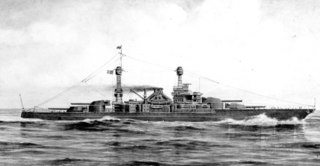
The first South Dakota class was a group of six battleships that were laid down in 1920 for the U.S. Navy, but were never completed; designed to achieve 23 knots, they represented an attempt to catch up with the increasing fleet speeds of its main rivals, the British Royal Navy and Imperial Japanese Navy.

L 20e α was a design for a class of battleships to be built in 1918 for the German Kaiserliche Marine during World War I. Design work on the class of battleship to succeed the Bayern-class battleships began in 1914, but the outbreak of World War I in July 1914 led to these plans being shelved. Work resumed in early 1916 and lessons from the Battle of Jutland, fought later that year, were incorporated into the design. Reinhard Scheer, the commander of the fleet, wanted larger main guns and a higher top speed than earlier vessels, to combat the latest ships in the British Royal Navy. A variety of proposals were submitted, with armament ranging from the same eight 38 cm (15 in) guns of the Bayern class to eight 42 cm (16.5 in) guns.

The Lexington-class battlecruisers were officially the only class of battlecruiser to ever be ordered by the United States Navy. While these six vessels were requested in 1911 as a reaction to the building by Japan of the Kongō class, the potential use for them in the U.S. Navy came from a series of studies by the Naval War College which stretched over several years and predated the existence of the first battlecruiser, HMS Invincible. The fact they were not approved by Congress at the time of their initial request was due to political, not military considerations.
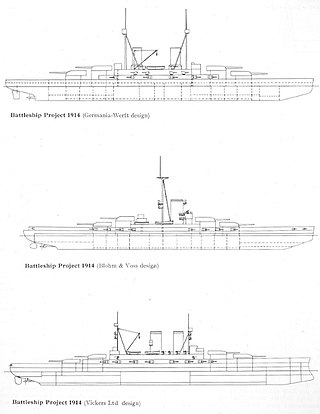
A Dutch proposal to build new battleships was originally tendered in 1912, after years of concern over the expansion of the Imperial Japanese Navy and the withdrawal of allied British warships from the China Station. Only four coastal defense ships were planned, but naval experts and the Tweede Kamer believed that acquiring dreadnoughts would provide a stronger defense for the Nederlands-Indië, so a Royal Commission was formed in June 1912.
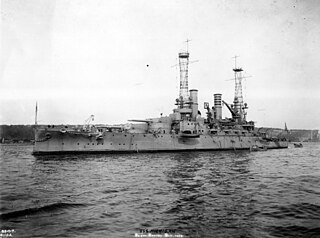
Two South Carolina-class battleships, also known as the Michigan class, were built for the United States Navy in the early twentieth century. Named South Carolina and Michigan, they were the first American dreadnoughts—powerful warships whose capabilities far outstripped those of the world's older battleships.

The Pennsylvania class consisted of two super-dreadnought battleships built for the United States Navy just before the First World War. Named Pennsylvania and Arizona, after the American states of the same names, the two battleships were the United States' second battleship design to adhere to the "all or nothing" armor scheme. They were the newest American capital ships when the United States entered the First World War.
The J3 class battlecruiser was a design study conducted during the Royal Navy's 1921 Fleet modernization programme. As a follow-on to the Admiral-class battlecruiser, the J3 class incorporated all the lessons learned from the First World War, specifically the battle of Jutland. The design was seen as an improvement to the Admiral class by virtue of its heavier and improved armouring scheme, specifically the deck armour, although the offensive armament remained roughly the same. The design was superseded by the I3 and G3 battlecruiser designs, as both mounted a heavier main armament, and further improved the protection scheme, on roughly the same tonnage. The 1921 fleet program was cancelled due to signing of the Washington Naval Treaty in 1922, which limited the size and armament of battleships to 35,000 long tons (36,000 t) and no gun bigger than 16 inches (406 mm).























